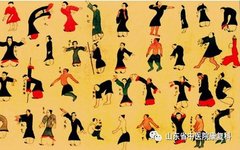Bian (stone scraping), acupuncture, moxibustion, herbal medicine, and Daoyin (Guiding and Pulling) are collectively known as the five major medical techniques of ancient China. Daoyin techniques are primarily used to promote the flow of Qi (vital energy) and blood, as well as to prevent and treat diseases. Their characteristic feature is the combination of breathing exercises and physical movements. The history of Daoyin is long and profound, making it an important component of Traditional Chinese Medicine (TCM) and a brilliant treasure of Chinese civilization.

Origin
The origins of Daoyin can be traced back to ancient times. According to the records in the Lüshi Chunqiu (Annals of Lü Buwei), during the reign of Emperor Yao, the Central Plains region experienced severe flooding, leading to a cold and damp climate. People suffered from stagnation of Qi and blood, making them prone to joint pain and similar ailments. “Therefore, they performed great dances to promote the flow of Qi and blood.” The ancients used specific body movements, or “dance,” to mobilize the joints and achieve therapeutic effects. At this time, Daoyin had already begun to take shape. Later generations referred to Daoyin as “Xuandao Fa (method of promoting flow),” which originated from this practice.
Development
Spring and Autumn and Warring States Periods
The Xingqi Yupei Ming, preserved from the Spring and Autumn and Warring States periods, is a small jade pillar with twelve faces inscribed with 45 characters, specifically describing the methods and effects of promoting Qi. This indicates that Daoyin already had a certain theoretical foundation and technical methods during this time.
Qin and Han Dynasties
The advancements in medicine during the Qin and Han dynasties directly spurred a rapid development of Daoyin techniques. The Daoyin Tu, a silk painting unearthed from the Mawangdui tomb in Changsha in 1973, is currently the earliest existing comprehensive colored silk illustration of Daoyin techniques, depicting 44 Daoyin movements. Over time, these techniques evolved into forms such as Ba Duan Jin (Eight Pieces of Brocade) and Wu Qin Xi (Five Animal Frolics). The Yin Shu, discovered in a Western Han tomb in Hubei in 1984, is the earliest known monograph on Daoyin, documenting 55 named Daoyin techniques and revealing the glorious history of Daoyin during the Qin and Han periods. The famous physician Hua Tuo from the Han and Wei dynasties created the first set of Daoyin techniques, the Wu Qin Xi (Five Animal Frolics), which marked a qualitative leap from single movements to routine Daoyin.
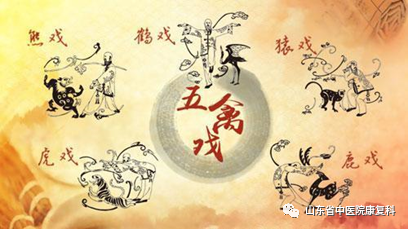
Wei, Jin, Southern and Northern Dynasties
During the Wei, Jin, Southern and Northern Dynasties, Daoyin techniques became widely popular. The publication of texts such as the Huang Ting Jing, Bao Pu Zi, and Yangxing Yanming Lu had a significant impact on the development of Daoyin in later generations. Tao Hongjing recorded the famous “Six Character Formula” in the “Fuqiqi Liao Bing Pian” of the Yangxing Yanming Lu, which states: “Inhale with one, exhale with six. Inhaling one refers to breathing in; exhaling six refers to blowing, calling, laughing, sighing, hissing, and exhaling, all of which are forms of exhalation.”
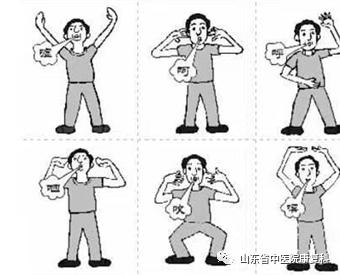
Sui and Tang Dynasties
During the Sui and Tang dynasties, Daoyin techniques reached their peak. Chao Yuanfang recorded a total of 289 “health preservation methods” or “Daoyin methods” in his work Zhu Bing Yuan Hou Lun, with 213 specific methods, along with “health preservation methods for Daoyin.” The Tang dynasty’s Hu Yan authored the Huang Ting Nei Jing: Wu Zang Liu Fu Tu, which documented Daoyin methods that combined pathology, seasonal changes, and herbal treatments.
Song, Jin, and Yuan Dynasties
The Song, Jin, and Yuan dynasties marked another peak in the development of Daoyin techniques, with the most significant achievement being the standardization and popularization of Ba Duan Jin. Ba Duan Jin was initially developed in a seated and standing form during the Northern Song period and was fully established and widely disseminated by the late Southern Song period.
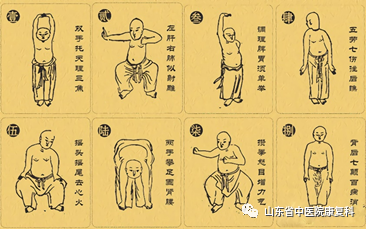
Ming and Qing Dynasties
During the Ming and Qing dynasties, Daoyin techniques continued to innovate and develop through critical inheritance. The Yi Jin Jing (Muscle-Tendon Change Classic) was compiled by Ziyin Dao Ren during this time, and the “Six Character Formula” and “Five Animal Frolics” were further refined.
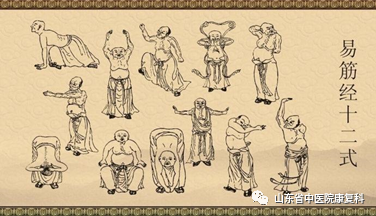
In modern times, Daoyin techniques have given rise to a new product through development and inheritance—Jianshen Qigong (Health Preservation Qigong), which currently includes 9 sets of popularized methods and 4 sets of competitive methods.


